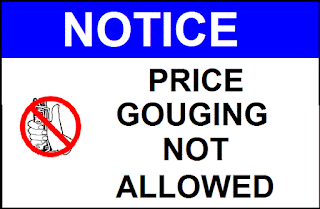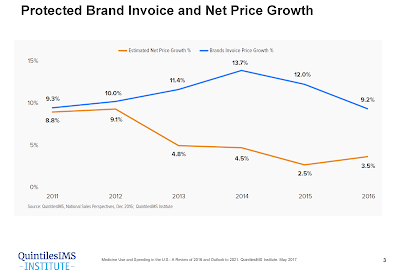Ohio Medicaid pulls the plug on contracts with two big PBMs over ‘spread’ pricing
 |
| Cost-Effective Pharmacy Benefits Management Begins and Ends with Education. Click Here to Begin Yours. |
 |
| Cost-Effective Pharmacy Benefits Management Begins and Ends with Education. Click Here to Begin Yours. |
Always include a semi-annual market check in your PBM contract language. Market checks provide each payer the ability, during the contract, to determine if better pricing is available in the marketplace compared to what the client is currently receiving.
When better pricing is discovered the contract language should stipulate the client be indemnified. Do not allow the PBM to limit the market check language to a similar size client, benefit design and/or drug utilization. In this case, the market check language is effectually meaningless.
 |
| Source: Berkley Research Group and IMS Quintiles |
Pfizer Inc. CEO Ian Read said on Tuesday July 31, 2018, “drugmakers will likely get rid of secret discounts to middlemen that have become a focus of the U.S. drug-cost debate.” What are these secret discounts and who are these middlemen to whom Ian Read is referring?
Rebates are secret discounts drugmakers use to compete for coveted spots on pharmacy benefit managers’ formularies or lists of covered drugs. The intent of these discounts is to help lower overall drug costs for third-party payers and patients.
Middlemen who negotiate drug rebates on behalf of employers and health plans but hide rebate revenue are called non-fiduciary pharmacy benefit managers or NFPBMs. Whether or not rebates, as a hidden cash flow, completely go away or how long it will take for drugmakers to get rid of them is unclear.
Let’s not be naive. If rebates go away do you believe for one second CVS Health’s or Optum’s PBM revenues will decline? Not a chance as they will shift your costs elsewhere. Here’s a look at some of the ways non-fiduciary PBMs will grow revenue despite the elimination of rebates.
3) Unsophistication. PBMs, and healthcare systems for that matter, are applying their drug management expertise to the medical side far more than they are letting on. Complicated algorithms determine which drugs stay on the medical benefit versus the pharmacy benefit, for example. The decision-making process as you might guess considers cost share. It took 20 years for rebates to come under serious fire. Non-fiduciary PBMs are counting on the unsophisticated plan sponsor to wait another 20 years before taking action on exorbitant drug prices on the medical side.
The Trump administration is weighing a proposal to overhaul regulations governing the rebates, which could limit their use and increase competition between drugmakers, while helping some patients. The federal anti-kickback statute allows “safe harbor” to protect the use of rebates. I can’t say that I blame the administration.
Non-fiduciary PBMs are pocketing the rebates and sharing them with insurers. Too little of that revenue goes to self-insured employers and even less, if any, to the patients whose prescriptions make the rebate revenue happen.
Even more, non-fiduciary PBMs generate the most rebate revenue on prescription drugs for the sickest patients. Of the more than $100 billion in brand rebate revenue non-fiduciary PBMs receive annually, half are from medicines for cancer, MS, HIV, hepatitis C, etc.
While non-fiduciary PBMs should be criticized, it’s important to note that they are playing with house money. That is, the rebate revenue comes from drugmakers. I believe more drugmakers will start passing rebates directly to third-party payers and patients in the form of lower list prices. Ultimately, lower list prices should reduce cost sharing, improve adherence and save lives.
Here is what some participants have said about the webinar.
A snapshot of what you will learn during this 30 minute webinar:
Always include a semi-annual market check in your PBM contract language. Market checks provide each payer the ability, during the contract, to determine if better pricing is available in the marketplace compared to what the client is currently receiving.
When better pricing is discovered the contract language should stipulate the client be indemnified. Do not allow the PBM to limit the market check language to a similar size client, benefit design and/or drug utilization. In this case, the market check language is effectually meaningless.
 |
| List of Biosimilar Drugs and their Marketing Status (Updated September 14, 2017) |
In 2017, biosimilars generated $3 billion worldwide in revenue and present growing market competition to the specialty biotech market. Escalating specialty drug costs present a challenge for many employers who struggle to balance health care spend with business financial livelihood.
Based on 2017 FDA research, the delayed market launch of nine biosimilars represented $4.5 billion in potential savings. As part of the FDA Biosimilar Action Plan, biosimilar drugs are poised to offer a solution that could help deliver significant cost advantages without compromising therapeutic efficacy, safety, or quality.
Biosimilars are biologic drugs that are highly similar in structure and function to existing FDA approved reference drugs. With fully established FDA safety and efficacy data, reference drugs are used as the benchmark to which biosimilars are compared to.
For example, Neupogen is the reference drug for both biosimilar products Zarxio and Granix. Biosimilars must demonstrate no clinically meaningful efficacy differences and equal safety to gain FDA approval. Biosimilars should not be viewed as generic drugs, but rather an alternative form of brand medications that would usually be categorized as specialty.
 An increasingly popular culprit in the debate over high drug prices is the pharmaceutical rebate, the after-the-fact discounts that form the heart of the nation’s arcane — many would say broken — market for prescription drugs.
An increasingly popular culprit in the debate over high drug prices is the pharmaceutical rebate, the after-the-fact discounts that form the heart of the nation’s arcane — many would say broken — market for prescription drugs.
Tyrone’s Commentary:
My thoughts on rebates are well-documented throughout this blog. Do a quick search to read any number of related posts. The bottom line is plan sponsors are entitled to every penny a manufacturer pays to a PBM for a drug put on its formulary and for some drugs dispensed on the medical side. Most plan sponsors believe they are getting 90% or more of the rebates back but in many cases the actual number is far less.
Now, a growing chorus wants to get rid of them, or at least change the way they are applied after drug companies have already set their prices. Rebates, critics say, have pushed up the list price of brand-name drugs, which consumers are increasingly responsible for paying. Insurers generally get to keep the rebates without passing them along to their members.
Last week, the drug industry’s largest trade group, the Pharmaceutical Research and Manufacturers of America, took aim at the rebate system, proposing a change to the way middlemen handle rebates, and how those companies are paid.
 Drug costs account for much of the rise in medical expenses; prescription drug plans can make up from 18% to 25% of total healthcare costs, according to a PwC report. And for specialty drugs, the percentage can rise as much as 30%. Employers can reap some of the savings through rebates and discounts from pharmacy benefit managers (PBMs). Savings, however, are mostly on brand-name drugs, rather than less costly generic drugs.
Drug costs account for much of the rise in medical expenses; prescription drug plans can make up from 18% to 25% of total healthcare costs, according to a PwC report. And for specialty drugs, the percentage can rise as much as 30%. Employers can reap some of the savings through rebates and discounts from pharmacy benefit managers (PBMs). Savings, however, are mostly on brand-name drugs, rather than less costly generic drugs.
Some proposals for saving on drug and medical costs include: conducting clinical reviews of drug formularies; eliminating unnecessary or low-value medical procedures; and offering account-based health plans (ABHPs) with health savings accounts (HSAs), strategies attributed to “high-performing” organizations, according to a Willis Towers Watson study released in March.
The industry has seen a number of big moves, company-wise, in the pharmaceutical space in recent months, including CVS’s deal to buy Aetna — a move that experts say could force employers to rethink common assumptions about how they purchase prescription drug benefits. Amazon, also, recently made headlines for its purchase of PillPack, an online pharmacy offering home delivery.
Always include a semi-annual market check in your PBM contract language. Market checks provide each payer the ability, during the contract, to determine if better pricing is available in the marketplace compared to what the client is currently receiving.
When better pricing is discovered the contract language should stipulate the client be indemnified. Do not allow the PBM to limit the market check language to a similar size client, benefit design and/or drug utilization. In this case, the market check language is effectually meaningless.
 |
| Click to Learn More |
Lately, the big pharmaceutical firms have pointed at PBMs to deflect the blame for their sky-high drug prices. President Donald Trump seems to share this view. However, PBMs are just middlemen whose only purpose is to lubricate the relationship between insurers, Big Pharma and pharmacy chains. They let pharmacies know what your plan covers and what you owe – a valuable service worth a nominal payment.
But PBMs also work the system by collecting rebates of up to 25 percent from drug manufacturers as an agent for insurers. They then pass some, but not all, of them on to the insurance companies and their customers. We believe these rebates should be understood for what they really are: bribes that Big Pharma pays in an attempt to bias insurers to favor their higher-priced products over others.
Tyrone’s Commentary:
Discounts off AWP, guaranteed rebate dollars per eligible claim or low administrative fees are simply a means to an end. The most important number to calculate is your PBM service fee. It is determined, in large part, on how adept a plan sponsor is at uncovering hidden PBM cash flows. If you’re a self-funded employer, broker or consultant who still determines whether or not you won fair pricing based primarily on AWP discounts or guaranteed rebate dollars you’re mired in the status quo thus are vulnerable to excessive overpayments. Those self-funded employers who demand full disclosure of PBM service fees and will not accept anything less are doing exceptional work. Uncovering PBM service fees allow you maybe for the first time to see how much your PBM service actually costs which is not the same as your pharmacy plan costs. Hidden in your pharmacy plan cost is the PBM service fee. It’s time to start pulling this number out.
Insurers are not blameless. They also try to buy business, creating unnecessary transaction costs in the process. For instance, employers typically hire brokers and consultants to advise them on coverage for their employees. Given the complexity of insurance plans, seeking such help is usually a rational decision.
But the hidden fact is that these middlemen, in addition to fees from their clients, are taking side payments from insurers up to 16 percent of the premium – clearly designed to bias their recommendations to employers. These payments are another case of unproductive transactions costs that can be eliminated by bargaining directly with insurers and drug companies.